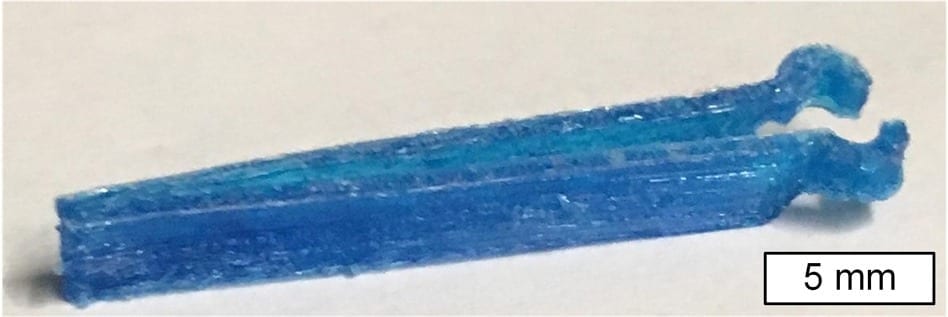
Inspired by origami, North Carolina State University researchers have found a way to remotely control the order in which a two-dimensional (2-D) sheet folds itself into a three-dimensional (3-D) structure.
“A longstanding challenge in the field has been finding a way to control the sequence in which a 2-D sheet will fold itself into a 3-D object,” says Michael Dickey, a professor of chemical and biomolecular engineering at NC State and co-corresponding author of a paper describing the work. “And as anyone who has done origami – or folded their laundry – can tell you, the order in which you make the folds can be extremely important.”
“The sequence of folding is important in life as well as in technology,” says co-corresponding author Jan Genzer, the S. Frank and Doris Culberson Distinguished Professor of Chemical and Biomolecular Engineering at NC State. “On small length scales, sequential folding via molecular machinery enables DNA to pack efficiently into chromosomes and assists proteins to adopt a functional conformation. On large length scales, sequential folding via motors helps solar panels in satellites and space shuttles unfold in space. The advance of the current work is to induce materials to fold sequentially using only light.”
Specifically, the researchers have developed a technique to design and fabricate 2-D materials that can be controlled remotely in order to trigger any of the given folds to take place, in any order.
Dickey and Genzer were early leaders in the field of self-folding 3-D structures. In their landmark 2011 paper, the researchers outlined a technique in which a pre-stressed plastic sheet was run through a conventional inkjet printer to print bold black lines on the material. The material was then cut into a desired pattern and placed under an infrared light, such as a heat lamp.
The printed lines absorbed more energy than the rest of the material, causing the plastic to contract – creating a hinge that folded the sheets into 3-D shapes. By varying the width of the printed lines, or hinges, the researchers were able to change how far – and how quickly – each hinge folds. The technique is compatible with commercial printing techniques, such as screen printing, roll-to-roll printing, and inkjet printing, that are inexpensive and high-throughput but inherently 2-D.
The new advance uses essentially the same technique, but takes advantage of the fact that different colors of ink absorb different wavelengths, or colors, of light.
“By printing the hinges in different colors, we can control the order of the folds by altering the wavelengths of light that shines on the 2-D sheet,” Genzer says.
For example, if one hinge is printed in yellow and another hinge is printed in blue, the researchers can make the yellow hinge fold by exposing it to blue light. The blue hinge won’t fold, because blue ink doesn’t absorb blue light. The researchers can then make the blue hinge fold by exposing the sheet to red light.
In addition, by manipulating the colors of ink, the researchers were also able to get hinges to fold sequentially when exposed to a single wavelength of light. This is possible because some colors will absorb a given wavelength of light more efficiently than others.
“This is a proof-of-concept paper, but it opens the door to a range of potential applications using a simple and inexpensive process,” Dickey says.
“Ultimately, people are interested in self-assembling structures for multiple reasons, from shipping things in a flat package and having them assemble on site to having devices self-assemble in ‘clean’ environments for medical or electronic applications.”
Learn more: Researchers Remotely Control Sequence in Which 2-D Sheets Fold Into 3-D Structures
[osd_subscribe categories=’phase-change-materials-2′ placeholder=’Email Address’ button_text=’Subscribe Now for any new posts on the topic “PHASE-CHANGE MATERIALS”‘]
Receive an email update when we add a new PHASE-CHANGE MATERIALS article.
The Latest on: Phase-change materials
[google_news title=”” keyword=”phase-change materials” num_posts=”10″ blurb_length=”0″ show_thumb=”left”]
via Google News
The Latest on: Phase-change materials
- With the aid battle won in Washington, we must help Ukraine win the war’s next phaseon April 27, 2024 at 1:00 pm
The additional U.S. aid, on top of Europe’s significant contributions, gives Ukraine new hope in the war. The ultimate goal should be setting the conditions in 2024 for Ukraine to launch another ...
- LADOTD begins phase one of Crescent City Connection lighting projecton April 26, 2024 at 4:17 pm
Starting Tuesday, April 30, the Louisiana Department of Transportation and Development says one lane in each direction of the Crescent City Connection bridge will be closed until August. The bridge ...
- More traffic changes announced amid Youngstown road projecton April 25, 2024 at 9:57 am
YOUNGSTOWN, Ohio (WKBN) – A new phase of the SMART2 Roadway project begins next week, leading to more traffic changes in Youngstown. According to a news release from the city’s Department of Public ...
- Planting trees to combat climate change on Arbor Dayon April 25, 2024 at 3:42 am
According to the Arbor Day Foundation, they celebrate by planting and distributing over 10 million trees each year.
- Towards novel promising perovskite-type ferroelectric materials: High-pressure synthesis of rubidium niobateon April 24, 2024 at 5:00 pm
Additionally, they characterized how polarization changes across a wide temperature range during phase transitions. This breakthrough can lead to new design guidelines for ferroelectric materials.
- The story of the first Alor people adapting to climate change 43,000 years agoon April 24, 2024 at 11:00 am
As humans, our greatest evolutionary advantage has always been our ability to adapt and innovate. When people first reached the expanded coastline of Southeast Asia around 65,000 years ago, and faced ...
- Multifunctional Composite Phase Change Materials Shielding for Electronicson April 23, 2024 at 5:00 pm
In a recent paper published in the journal Nano Energy Research, Chinese researchers at Beijing Normal University have been developing multifunctional composite phase change materials (PCMs) shielding ...
- Aerogel-based phase change materials improve thermal management, reduce microwave emissions in electronic deviceson April 23, 2024 at 9:24 am
Electronic devices are getting more and more complex as they are built to carry out an ever-increasing number of functions. This can be seen in the increased functionality in our personal devices such ...
- Applied Materials: Capitalizing On Centura Sculpta And OLED Expansionon April 23, 2024 at 4:10 am
Current stock price does not fully reflect the true value of Applied Materials as investors aren’t factoring in the potential growth. Find out if AMAT is a buy.
via Bing News










